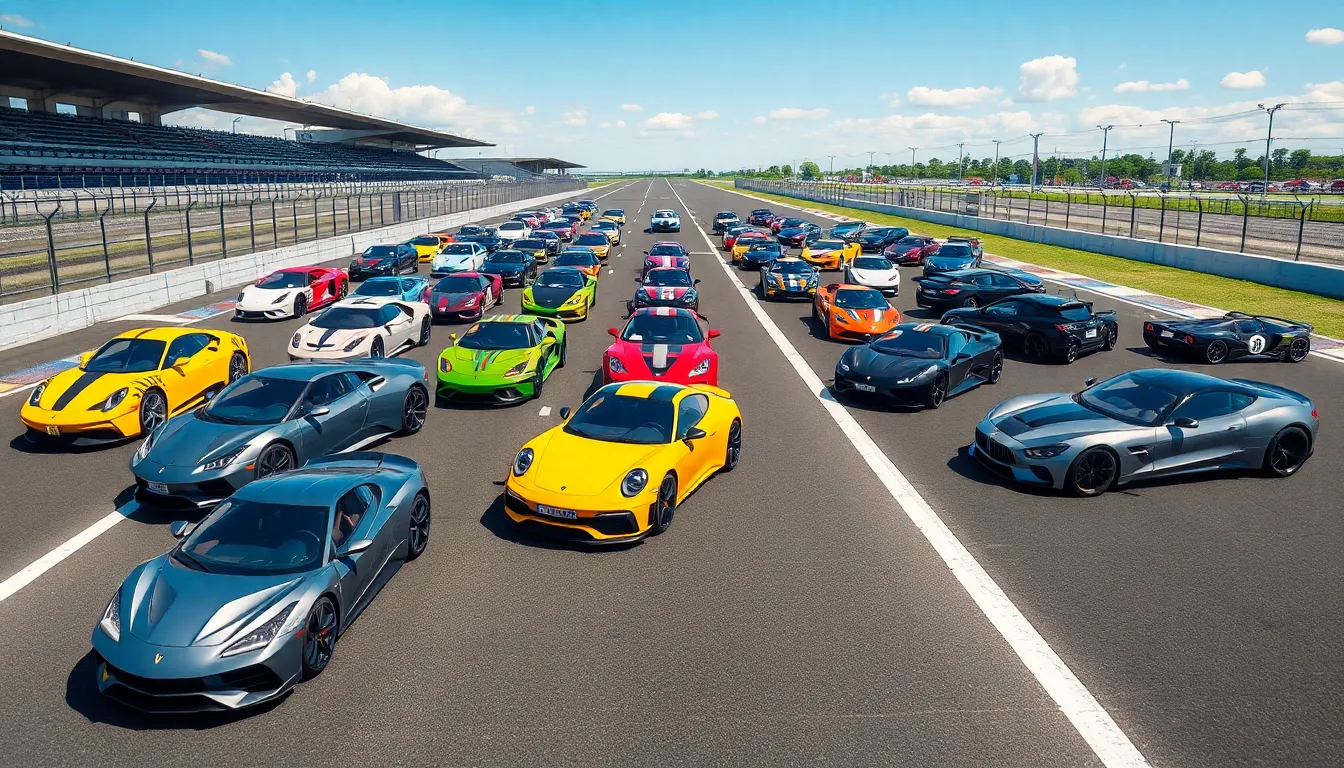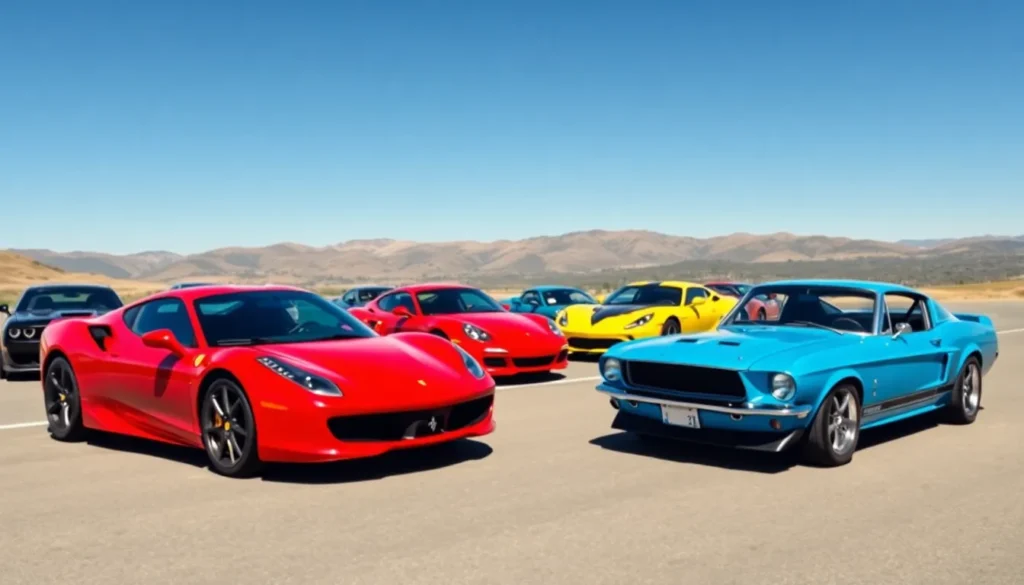In the world of racing games, few titles rev up excitement like Gran Turismo. With its jaw-dropping graphics and realistic driving physics, it’s a playground for car enthusiasts and casual gamers alike. But what really gets the engines roaring is the impressive car list that keeps expanding with each installment. Whether you’re dreaming of zipping around in a sleek Ferrari or cruising in a classic Mustang, Gran Turismo has something for every gearhead.
Table of Contents
ToggleOverview of Gran Turismo Car List
Gran Turismo features a comprehensive car list that appeals to diverse automotive enthusiasts. Each title in the series introduces an expanded roster of vehicles, showcasing brands from Ferrari to Ford. Sleek sports cars, powerful supercars, and historic models contribute to the game’s allure.
Customization plays a significant role within the car list. Players can modify performance parts, aesthetics, and tuning settings, enhancing the gaming experience. Different models suit various driving styles, ensuring no two races feel the same.
The franchise boasts cars spanning multiple decades, making it a nostalgic journey for many. Iconic vehicles like the Ford Mustang from the 1960s share space with modern hypercars like the Bugatti Chiron. Unique features, such as detailed interiors and realistic handling, further immerse players.
In addition, Gran Turismo showcases around 400 unique car models, emphasizing authenticity. Licensing agreements with manufacturers allow the game to accurately reflect the real-world performance of each vehicle. This attention to detail cultivates a realistic driving environment.
Event schedules often highlight specific car categories, encouraging players to explore different makes and models. Challenges range from street racing to endurance trials, ensuring a dynamic gameplay experience. Through these varied events, players can appreciate the unique capabilities each car brings to the track.
Overall, Gran Turismo’s car list represents automotive passion, blending entertainment with education about vehicles. Players appreciate the intertwining of simulation and fun, ultimately reinforcing its status as a premier racing game.
Categorization of Cars

Gran Turismo features a diverse array of cars categorized into specific groups, enhancing player engagement and gameplay variety.
Road Cars
Road cars represent a significant portion of Gran Turismo’s collection. They include everyday vehicles, high-performance models, and classic favorites. Brands like Toyota, Honda, and Ferrari offer players choices that reflect both nostalgia and contemporary design. Players can experience the handling and performance of these cars on various tracks. Customization options allow for personal touches, letting drivers modify aesthetics and performance to match their preferences. This blend of familiar and exciting options makes road cars appealing in the game.
Racing Cars
Racing cars are engineered for high-speed performance and competitive racing. This category showcases vehicles from various motorsport disciplines like Formula 1 and endurance racing. Manufacturers such as Porsche and McLaren create models that emphasize speed and aerodynamics. Players benefit from unique driving dynamics that replicate real-world racing characteristics. Each racing car challenges players to master different handling styles and techniques. The distinct characteristics of these vehicles make racing a thrilling experience.
Concept Cars
Concept cars push the boundaries of automotive design and technology in Gran Turismo. These vehicles represent innovative ideas that manufacturers showcase for future models. Players encounter futuristic designs and advanced engineering features. Automakers like BMW and Nissan introduce models that often remain exclusive to the gaming world. Engaging with these vehicles allows players to explore cutting-edge technology. Concept cars add an intriguing dimension, blending fantasy and realism in gameplay.
Notable Manufacturers
Gran Turismo features a variety of notable manufacturers, each offering unique vehicles that enhance the gaming experience.
Toyota
Toyota’s presence in Gran Turismo highlights reliable performance and versatility. Iconic vehicles like the Supra and the GT86 provide players with affordable yet thrilling driving experiences. Featuring cars that range from fuel-efficient sedans to high-performance sports models, Toyota caters to diverse driver preferences. The brand emphasizes both stability and handling, leading to enjoyable gameplay on various tracks. Additionally, Toyota’s innovative hybrid models showcase advancements in automotive technology, appealing to environmentally conscious players.
Ferrari
Ferrari embodies luxury and speed within Gran Turismo. The brand’s renowned supercars, such as the LaFerrari and F8 Tributo, set new benchmarks for performance. Players experience exhilarating acceleration and precise handling that mirror Ferrari’s real-world racing pedigree. Offering a mix of classic and modern designs, Ferrari appeals to fans of all ages. Iconic models often come equipped with advanced aerodynamics, contributing to their distinctive presence on the racetrack. The allure of Ferrari adds an authentic edge to Gran Turismo’s competitive environment.
Porsche
Porsche represents performance engineering in Gran Turismo with a lineup of thrilling vehicles. Models like the 911 and Cayman stand out for their exceptional handling and powerful engines. Players appreciate Porsche’s balance of speed and precision, making it a favorite among racing enthusiasts. The brand’s commitment to innovation shines through with their sleek designs and cutting-edge technology. Realistic driving dynamics elevate gameplay, providing a captivating experience. Porsche’s legacy in motorsport reinforces its relevance in the game’s extensive car list.
Featured Cars in Gran Turismo
The Gran Turismo car list showcases an impressive selection of vehicles that appeals to fans globally. Players can find around 400 unique models, categorized into road cars, racing cars, and concept cars. Each type provides a distinct driving experience, enhancing engagement.
Road cars include performances that range from everyday models to high-performance sports cars. Iconic vehicles like the Toyota Supra and Honda NSX highlight the category’s diversity, allowing players to appreciate both their power and handling. Muscular classics, such as the Ford Mustang, also create nostalgia for automotive enthusiasts.
Racing cars emphasize speed and precision. Players encounter renowned models from motorsport disciplines, like Formula 1, featuring brands such as Ferrari and McLaren. The Ferrari 488 GTB exemplifies luxury alongside unmatched handling capabilities, making it a favorite among gamers.
Concept cars introduce futuristic designs that captivate imaginations. Models like the Nissan Vision GT leverage cutting-edge technology, often limited to the virtual realm. These vehicles enable players to experience innovative engineering, typically not available in traditional automotive markets.
Notable manufacturers stand out in Gran Turismo, with Toyota, Ferrari, and Porsche leading the pack. Toyota offers a reliable lineup, encompassing everything from fuel-efficient sedans to rapid sports models. Ferrari resonates with performance and prestige, showcasing cars like the LaFerrari as ultimate racing machines. Porsche impresses with cars such as the 911 and Cayman, known for superb handling and speed.
Gran Turismo’s ongoing evolution ensures players constantly discover new vehicles, enhancing their gaming experience while celebrating automotive excellence.
Updates and Expansions
Gran Turismo regularly enhances its car list through updates and expansions. Developers introduce new vehicles to keep the game’s extensive catalog fresh and engaging. Each update typically adds several new cars, sometimes featuring limited-edition models that appeal to collectors. Recent expansions have included additional tracks and events, creating new opportunities for players to experience unique challenges.
Current updates may also refine existing vehicles, improving performance and handling based on community feedback. Manufacturers often collaborate with the game to ensure features accurately reflect real-world capabilities. For example, recent patches incorporated improved aerodynamics for cars from brands such as Ferrari and Porsche.
Players can expect seasonal updates that coincide with automotive events, introducing special content aligned with real-world racing calendars. Such updates can spotlight new manufacturers or enhance the diversity of car categories available in the game. Additionally, players can look forward to themed events celebrating iconic vehicles or racing heritage, further enriching the gameplay experience.
Community engagement drives much of the update process, with feedback mechanisms allowing players to suggest desired cars and features. These insights often result in curated selections that resonate with the gaming audience. Overall, Gran Turismo’s commitment to regular updates and expansions fosters a dynamic environment, ensuring that its car list remains relevant and reflects the latest trends in the automotive industry.
Gran Turismo continues to captivate players with its impressive car list and realistic gameplay. By offering a diverse range of vehicles from iconic manufacturers and innovative concept cars, it caters to the tastes of both casual gamers and automotive enthusiasts. The game’s commitment to regular updates ensures that the car list remains fresh and relevant, reflecting the latest trends in the automotive industry.
As players explore various car categories and customization options, they experience the thrill of driving like never before. Gran Turismo not only showcases the beauty of automotive engineering but also fosters a dynamic and engaging gaming environment. This dedication to detail and player experience solidifies Gran Turismo’s position as a leading racing game in the market.







